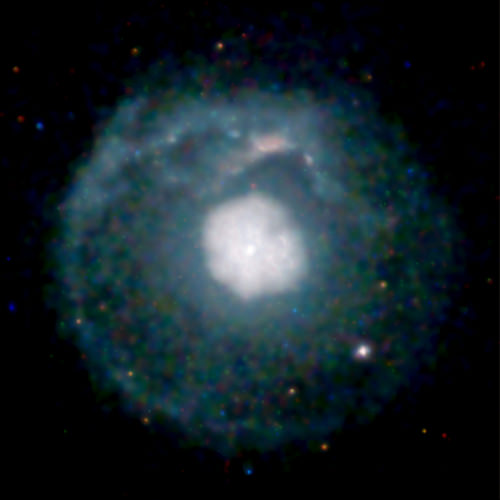A few nice good images I found:
A nearby galaxy cluster about 65 million light years from Earth.

Image by Smithsonian Institution
Description: Chandra’s mosaic of images of the Fornax cluster reveals that the vast cloud of ten-million-degree Celsius gas in the core of the cluster has a swept-back cometary shape that extends for more than half a million light years. This geometry suggests that the hot gas cloud is moving through a larger, but less dense cloud of gas that creates an intergalactic headwind. The core motion, combined with optical observations of the motion of a group of galaxies falling toward the core, indicates that the cluster lies along a large, unseen, filamentary structure composed mostly of dark matter. Most galaxies, gas, and dark matter in the universe are thought to be concentrated in such filaments, and galaxy clusters are thought to form where the filaments intersect.
Creator/Photographer: Chandra X-ray Observatory
NASA’s Chandra X-ray Observatory, which was launched and deployed by Space Shuttle Columbia on July 23, 1999, is the most sophisticated X-ray observatory built to date. The mirrors on Chandra are the largest, most precisely shaped and aligned, and smoothest mirrors ever constructed. Chandra is helping scientists better understand the hot, turbulent regions of space and answer fundamental questions about origin, evolution, and destiny of the Universe. The images Chandra makes are twenty-five times sharper than the best previous X-ray telescope. NASA’s Marshall Space Flight Center in Huntsville, Ala., manages the Chandra program for NASA’s Science Mission Directorate in Washington. The Smithsonian Astrophysical Observatory controls Chandra science and flight operations from the Chandra X-ray Center in Cambridge, Massachusetts.
Medium: Chandra telescope x-ray
Date: 2004
Persistent URL: https://photography.si.edu/SearchImage.aspx?id=5345
Repository: Smithsonian Astrophysical Observatory
Gift line: NASA/CXC/Columbia U./C.Scharf et
Accession number: fornax_xray
Hot Gas in Galactic Center: Chandra Turns Up the Heat in the Milky Way Center (A 130 light year region of the center of the Milky Way: Located about 26,000 light years from Earth, the region contains a supermassive black hole, hot gas, and thousands of X-

Image by Smithsonian Institution
Description: This X-ray image was produced by combining a dozen Chandra observations made of the central region of the Milky Way. The colors represent low (red), medium (green) and high (blue) energy X-rays. Chandra’s unique resolving power has allowed astronomers to identify thousands of point-like X-ray sources due to neutron stars, black holes, white dwarfs, foreground stars, and background galaxies. What remains is a diffuse X-ray glow extending from the upper left to the lower right, along the direction of the disk of the Galaxy. The Chandra data indicate that the diffuse glow is a mixture of 10-million-degree Celsius gas and 100-million-degree gas. Shock waves from supernova explosions are the most likely explanation for heating the 10-million degree gas, but how the 100-million-degree gas is heated is a mystery.
Creator/Photographer: Chandra X-ray Observatory
NASA’s Chandra X-ray Observatory, which was launched and deployed by Space Shuttle Columbia on July 23, 1999, is the most sophisticated X-ray observatory built to date. The mirrors on Chandra are the largest, most precisely shaped and aligned, and smoothest mirrors ever constructed. Chandra is helping scientists better understand the hot, turbulent regions of space and answer fundamental questions about origin, evolution, and destiny of the Universe. The images Chandra makes are twenty-five times sharper than the best previous X-ray telescope. NASA’s Marshall Space Flight Center in Huntsville, Ala., manages the Chandra program for NASA’s Science Mission Directorate in Washington. The Smithsonian Astrophysical Observatory controls Chandra science and flight operations from the Chandra X-ray Center in Cambridge, Massachusetts.
Medium: Chandra telescope x-ray
Date: 2004
Persistent URL: https://photography.si.edu/SearchImage.aspx?id=468
Repository: Smithsonian Astrophysical Observatory
Collection: Milky Way Collection
Gift line: NASA/CXC/UCLA/MIT/M.Muno et al.
Accession number: Sgra_xray















